How Much Money Is College For A Semester
Average Cost of College & Tuition
Report Highlights. The average price of higher* in the United States is $35,331 per student per twelvemonth, including books, supplies, and daily living expenses.
- The average cost of higher has more-than doubled in the 21st century, with an almanac growth rate of 6.8%.
- The boilerplate in-state pupil attending a public 4-year institution spends $25,487 for one academic year.
- The boilerplate cost of in-state tuition alone is $9,349; out-of-state tuition averages $27,023.
- The average traditional private university educatee spends a total of $53,217 per academic year, $35,807 of it on tuition and fees.
- Considering student loan interest and loss of income, the ultimate cost of a bachelor's degree can exceed $400,000.
*In this context, college refers to any 4-year postsecondary institution that offers an undergraduate caste plan; this is the average cost to first-time, full-fourth dimension undergraduates.
Jump to a state: AL | AK | AZ | AR | CA | CO | CT | DE | FL | GA | Howdy | ID | IL | IN | IA | KS | KY | LA | ME | MD | MA | MI | MN | MS | MO | MT | NE | NV | NH | NJ | NM | NY | NC | ND | OH | OK | OR | PA | RI | SC | SD | TN | TX | UT | VT | VA | WA | WV | WI | WY
| Public Institutions | Price of Tuition | Additional Expenses** | Cost of Attendance |
|---|---|---|---|
| 4-Year In-State | $9,349 | $16,138 | $25,487 |
| 4-Year Out-of-State | $27,023 | $16,138 | $43,161 |
| two-Year In-Land | $3,377 | $12,371 | $xv,748 |
| Private Institutions | Toll of Tuition | Additional Expenses | Toll of Attendance |
| 4-Year Nonprofit | $35,807 | $17,410 | $53,217 |
| four-Year For-profit | $14,957 | $20,168 | $35,125 |
| 2-Year Nonprofit | $16,898 | $17,121 | $34,019 |
| 2-Year For-profit | $fifteen,333 | $17,046 | $32,379 |
**Additional expenses exercise non account for potential lost income nor student loan involvement.
Related reports include Educatee Loan Debt Statistics | Average Cost of Community College | How Do People Pay for College? | Educatee Loan Refinancing
Boilerplate Total Cost of Higher
The cost of attendance (COA) refers to the total cost of tuition and fees, books and supplies, as well every bit room and board for those students living on campus. COA does non include transportation costs, daily living expenses, student loan involvement, etc.
- The average cost of attendance for a student living on campus at a public 4-year in-land institution is $25,487 per year or $101,948 over iv years.
- Out-of-state students pay $43,161 per year or $172,644 over 4 years; traditional private univeristy students pay $53,217 per year or $212,868 over 4 years.
- While 4 years is the traditional period to earn a bachelor'due south caste, simply 39% of students graduate inside 4 years.
- 60% of bachelor's degree earners graduate within 6 years, totaling an boilerplate of $152,922 for the cost of omnipresence.
- Students unable to work full-time stand to lose $40,612 in yearly income.
- Educatee borrowers pay an average of $1,898 in interest each year, and the average student borrower spends roughly 20 years paying off their loans.
- Because lost income and loan interest, the ultimate price of the average bachelor's degree may be every bit high equally $400,000.
| Public Institutions | Full Cost of Tuition | Total Additional Expenses | Full Cost of Caste |
|---|---|---|---|
| 4-Year In-State | $37,396 | $64,552 | $101,948 |
| 4-Year Out-of-State | $108,092 | $64,552 | $172,644 |
| two-Year In-State | $vi,754 | $24,742 | $31,496 |
| Individual Institutions | Total Cost of Tuition | Total Additional Expenses | Total Cost of Degree |
| 4-Yr Nonprofit | $143,228 | $69,640 | $212,868 |
| 4-Year For-profit | $59,828 | $80,672 | $140,500 |
| ii-Yr Nonprofit | $33,796 | $34,242 | $68,038 |
| 2-Year For-profit | $30,666 | $34,092 | $64,758 |
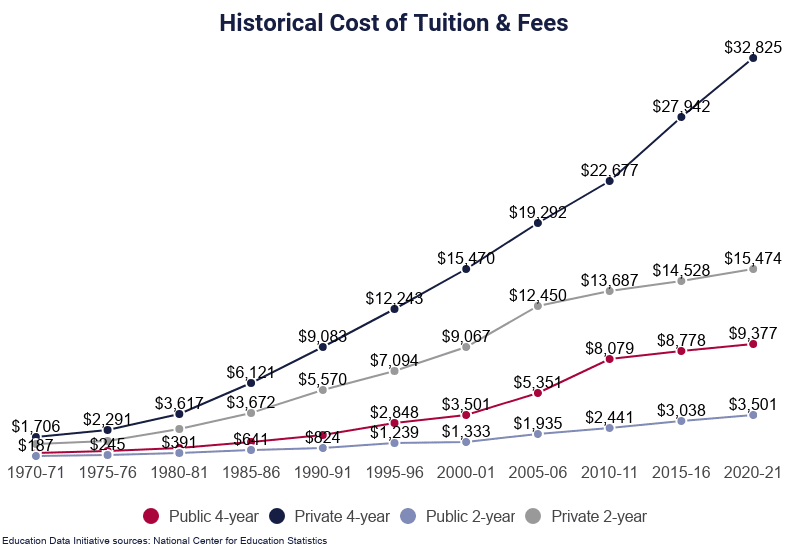
Average Price of Tuition
Tuition and fees make up the bulk of most college students' educational expenses.
- The average cost of attendance at whatever 4-year establishment is $35,331.
- The average toll of tuition at whatsoever 4-year institution is $28,775.
- At public 4-year institutions, the average in-land tuition and required fees full $ix,349 per year; out-of-country tuition and fees boilerplate $27,023.
- Amidst private 4-year institutions, the boilerplate tuition and fees at a nonprofit college full $35,807 annually; at for-turn a profit institutions, tuition and fees average $14,957 annually.
- The average cost of tuition and fees at whatever 2-year establishment is $three,621.
- At public 2-year institutions, or community colleges, in-district tuition and fees average $iii,377 annually; out-of-state students pay an average of $viii,126.
- At private two-year institutions, students pay $sixteen,898 in annual tuition and fees to attend nonprofit schools; for-turn a profit colleges accuse $xv,333.
- Among the comparatively few institutions that offer programs of less than 2 years, the average annual tuition and fees are $12,735.
- Virtually institutions designated less-than-2-year are private, for-profit schools.
- At that place are non enough information bachelor regarding these institutions to derive much statistical meaning.
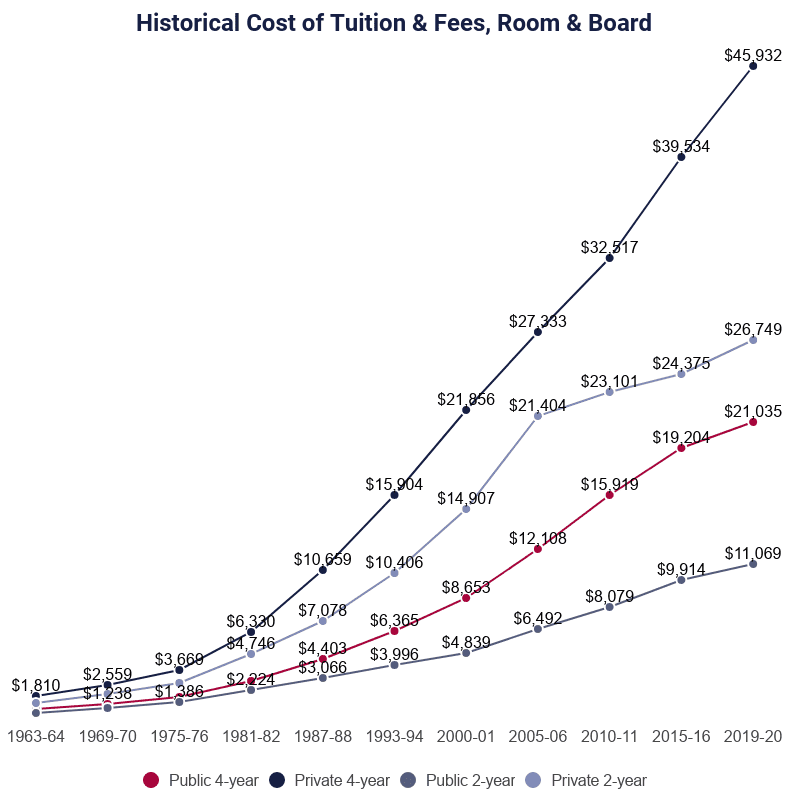
Historical Average Cost of Tuition
The cost of tuition has increased significantly over the last forty years even afterward adjusting for aggrandizement.
- In 1963, the annual toll of tuition at a iv-year public college was $243, which is $2,207 when adjusted for inflation.
- Adjusting for aggrandizement, the cost of tuition has increased by $7,142 or 324%.
- Between 2009-10 and 2019-20, before adjusting for inflation, the average tuition increase at 2-year colleges was $698 or 23.nine%.
- During the same menstruation, the average tuition increased 39.ii% or by $two,632 at public four-yr institutions and 47.ii% or $ten,500 at individual 4-year institutions.
- From 1989 to 2016, higher costs increased nearly 8 times faster than wages.
- In 1963, the cost of a 4-twelvemonth-caste was $5,144.
- In 1989, the same degree cost $52,892.
- Equally of the 2019-xx academic year, $101,584 is the cost of a bachelor's degree.

Boilerplate Cost of Books & Supplies
Some programs require more expensive materials than others, so the cost of books and supplies varies widely.
- At public 4-yr institutions, students pay an average of $i,291 annually on books and supplies.
- Books and supplies at individual, non-turn a profit institutions average $1,255; at individual, for-turn a profit institutions, the average cost is $1,103.
- At public 2-twelvemonth institutions, students pay an average of $1,538 each yr for books and supplies.
- At private, nonprofit institutions, books and supplies average $1,061; at private, for-profit two-year colleges, the boilerplate cost is $i,415.
Average Toll of Room & Board
The determining factor in the price of room and board is whether the educatee lives on or off campus.
- At four-yr institutions, the cost of room and board ranges from $9,395 to $12,540.
- At public four-year institutions, students living on campus pay an average of $11,303 annually for room and board; off-campus boarders pay $10,631.
- At individual, nonprofit institutions, on-campus boarders pay an boilerplate of $12,540 per academic year; students living off campus pay $9,943.
- At private, for-turn a profit institutions, on-campus room and board averages $10,188; students living off campus pay an average of $nine,395.
- There is wider variation in room and board costs at 2-year institutions, with costs ranging from $7,008 to $12,xxx.
- At public 2-year institutions, students living on campus pay an average of $vii,008 for their annual room and lath; students living off campus pay $ix,276.
- At private, nonprofit ii-year colleges, on-campus boarders pay $11,825 annually; off-campus boarders pay $9,692.
- Individual, for-turn a profit institutions charge $12,730 on boilerplate for room and board; students living off campus pay $8,899.
Boilerplate Additional Expenses
Necessary living expenses, such as transportation, personal care, and amusement, may be included in the final total toll of higher omnipresence. These expenses vary co-ordinate to the local economic system as well as the pupil'due south housing condition.
- Additional expenses at 4-year institutions range from $two,733 to $6,022.
- Students living on campus at a public 4-year institution pay an average of $3,468 in additional almanac expenses.
- Students who alive off campus may look to pay $four,213 if they do not live with family; for students living with family unit, additional expenses boilerplate $4,204.
- At private, nonprofit 4-twelvemonth institutions, students living on campus spend an average of $ii,733 on additional expenses.
- Students living off campus alone or with nonfamily members spend $six,022 on boosted living expenses; those living off campus with family spend $4,220.
- At individual, for-profit institutions, additional expenses average $4,749 for students living on campus.
- Students who live off campus spend an average of $4,431; those who live off campus with family spend $four,558.
- At 2-yr institutions, additional expenses boilerplate between $2,498 and $5,150.
- Students living on campus at a public 2-year institution pay an average of $three,390 in additional annual expenses.
- Students living off campus pay $iv,237 in additional expenses; students living off campus with family take an average of $4,258 in annual expenses.
- Students living on campus at 2-yr individual, nonprofit institutions pay an average of $2,501 in additional annual expenses.
- Students living off campus alone or with nonfamily members spend $4,753, while students living off campus with family members spend $iv,767.
- Students at private, for-profit two-yr institutions spend an average of $2,498 on additional expenses if they live on campus.
- Students living off campus spend $five,150 if they do not live with family members; students who alive off campus with family spend an boilerplate of $4,273.
Average Cost of Lost Income
1 of the largest expenses for students enrolled in higher may be the loss of potential income in fourth dimension spent studying instead of working.
- The average weekly income for a high school graduate is $781, or $twoscore,612 per yr.
- In four years, the boilerplate worker with a high school diploma earns $162,448.
- The unemployment rate amongst high school graduates is 9.0%, which is 26.viii% higher than the national average charge per unit.
- 17% of higher students have been homeless within the last 12 months.
- 56% of students experience housing insecurity each yr.
- Military veteran students are 61% more than likely to experience housing insecurity and 23% more likely to experience homelessness.
- 45% of students experience frequent food insecurity.
- Over 50% of students from 2-year institutions and 44% of four-yr students worry about running out of food.
- Nearly 50% of students cannot beget balanced meals.
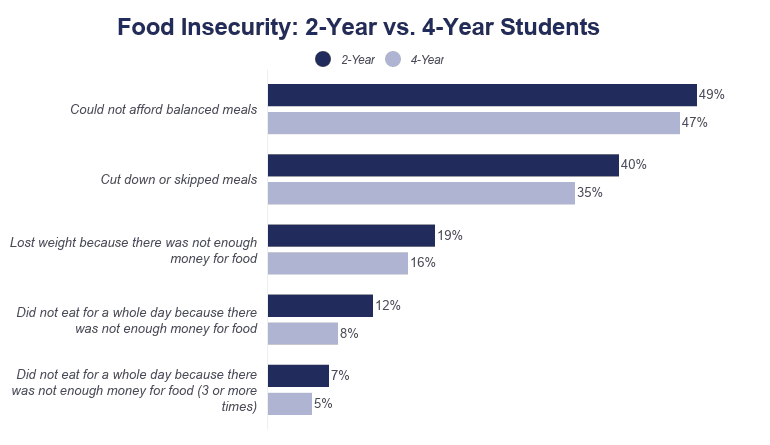
Average Cost of Borrowing for College
Most students borrow money to attend higher, later on repaying the chief plus interest. All of this compounds the longer the student is in school.
- The boilerplate educatee loan debt is $37,584.
- Each year, 34% of students borrow coin to pay for higher.
- The average student borrows more $30,000 to attend school.
See our reports on Student Loan Debt and How to Pay for College to acquire more than. 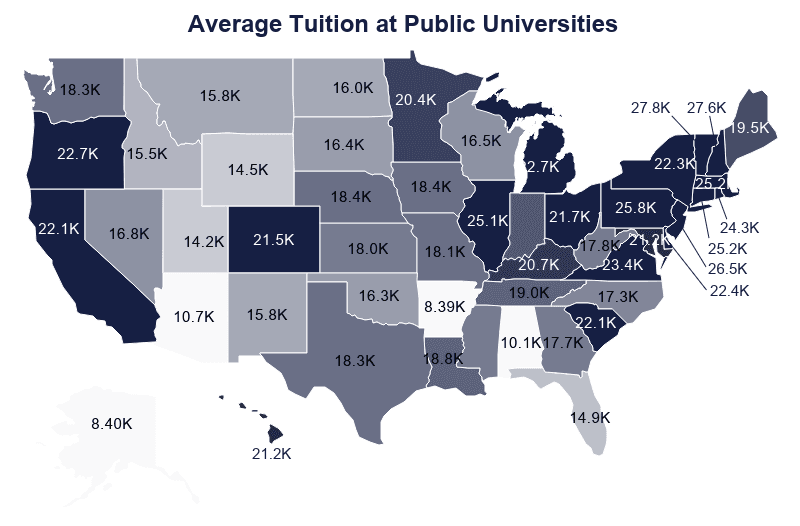
Boilerplate College Costs by Land
The boilerplate cost of in-state tuition and fees varies state-to-state and year-to-year. The range of difference is over $12,600.
- The about expensive public schools are in the Northeast, in and around what is traditionally called New England.
- Many of the nigh expensive private schools are also in this region.
- The average tuition amidst the 10 nearly expensive states for public university is $14,583.
- The least expensive schools are in the Southward and Plains regions; the least expensive individual schools are as well predominantly in the South.
- The average tuition among the states with the about reasonably priced public universities is $half-dozen,392.
For more than information, see our report on the Average Cost of College by State.
| Country | Tuition & Fees | Full |
|---|---|---|
| Vermont | $17,083 | $29,665 |
| New Hampshire | $16,679 | $28,734 |
| New Jersey | $14,360 | $28,372 |
| Massachusetts | $13,729 | $27,618 |
| Connecticut | $13,886 | $27,564 |
| Pennsylvania | $15,565 | $27,403 |
| Illinois | $14,455 | $25,806 |
| Rhode Isle | $13,105 | $25,592 |
| Virginia | $thirteen,655 | $25,074 |
| Delaware | $eleven,091 | $24,358 |
| Michigan | $13,315 | $24,086 |
| Arizona | $11,072 | $24,016 |
| New York | $8,467 | $23,875 |
| Oregon | $10,813 | $23,582 |
| California | $8,192 | $23,037 |
| South Carolina | $12,497 | $22,790 |
| Maryland | $9,714 | $22,504 |
| Ohio | $9,902 | $22,388 |
| Colorado | $ix,144 | $22,185 |
| Hawaii | $10,109 | $21,854 |
| Kentucky | $ten,888 | $21,799 |
| Minnesota | $eleven,748 | $21,611 |
| National Boilerplate | $ix,349 | $21,035 |
| Alabama | $x,323 | $xx,497 |
| Maine | $10,103 | $20,458 |
| Tennessee | $ten,164 | $20,360 |
| Indiana | $9,268 | $19,985 |
| Washington | $7,168 | $19,846 |
| Iowa | $9,373 | $19,809 |
| Alaska | $viii,297 | $19,619 |
| Nebraska | $8,582 | $nineteen,520 |
| Louisiana | $9,571 | $19,498 |
| Kansas | $9,088 | $xix,101 |
| Mississippi | $8,604 | $nineteen,080 |
| West Virginia | $eight,195 | $19,034 |
| Missouri | $8,992 | $18,734 |
| Texas | $8,598 | $18,711 |
| Georgia | $seven,457 | $18,554 |
| Arkansas | $8,689 | $eighteen,223 |
| Nevada | $6,023 | $17,987 |
| Wisconsin | $eight,764 | $17,784 |
| North Carolina | $7,228 | $17,569 |
| North Dakota | $8,628 | $17,449 |
| Southward Dakota | $8,978 | $17,298 |
| Oklahoma | $8,009 | $sixteen,960 |
| Montana | $6,967 | $16,732 |
| Idaho | $7,518 | $16,338 |
| New United mexican states | $7,152 | $16,193 |
| Florida | $4,463 | $15,237 |
| Wyoming | $iv,747 | $fourteen,901 |
| Utah | $6,700 | $14,619 |
| Commune of Columbia | $6,020 | Unavailable |
Most Expensive Individual Colleges
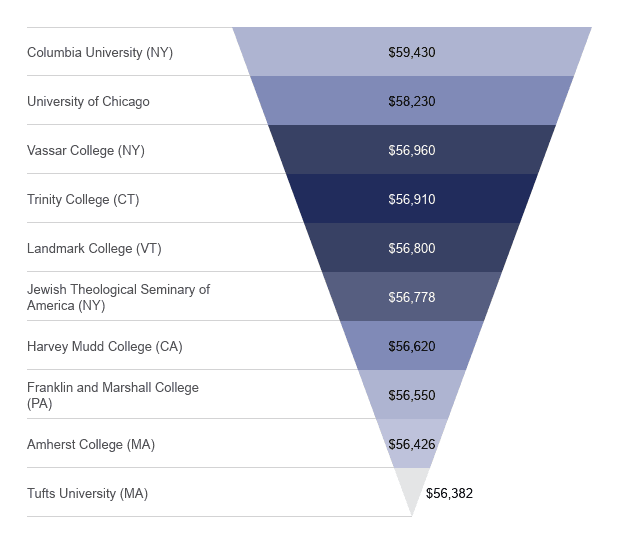
Least Expensive Individual Colleges
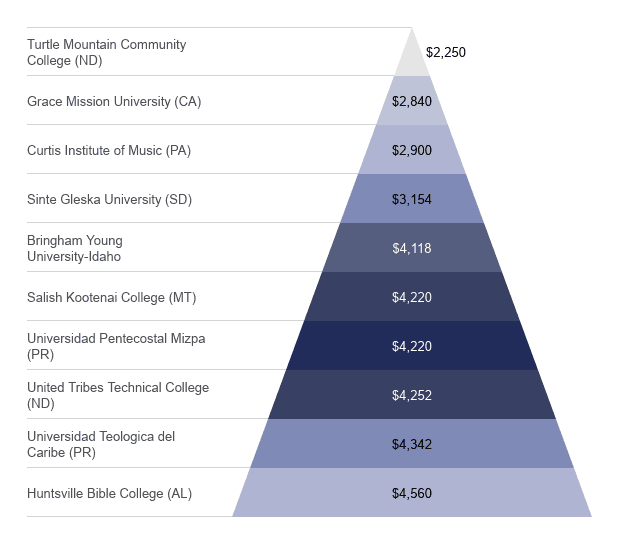
Analysis: Room and Lath On and Off Campus
Living expenses are the second-largest cost of higher after tuition and fees. Whether it is less expensive to live on or off campus depends on local rental markets. At Stanford University – located at the center of the San Francisco and San José urban sprawl – students would pay over $24,350 for a shared, off-campus apartment; room and board on campus, however, would cost $19,796 for an academic year. Nearly 60 percent of colleges do not accurately represent off-campus living costs. The Academy of California-Berkeley estimated a student would pay a median price of $14,360 per academic year (approx. 8 months) to live off-campus. In fact, it would cost a educatee $fifteen,176 with a roommate in a 2-bedroom apartment, adding $816 to their annual budget.
- 87% of students alive off-campus.
- Room and board charges accept doubled at four-year colleges even after adjusting for aggrandizement.
- In 1980, the boilerplate cost of room and board (adapted for inflation) was $4,800 compared to $9,798 in 2014.
- Between 2003 and 2014, increases for room charges at four-year colleges outpaced the growth of hire prices.
- In 2003 the average college room accuse was 29% under median rent.
- In 2014, the average college room charge was but 7% nether median rent.
Cost of College to Taxpayers
About public institutions receive funding from state and local governments. Colleges also receive federal funding through financial aid to students.
- In 2017, local and state governments spent approximately x% or $297 billion on higher education compared to 1977, when these expenditures were closer to $105 billion (later adjusting for inflation).
- 98% of state funding for higher teaching funding and 78% of federal college didactics funding went to public institutions.
- For virtually states, this was the third-largest expenditure, behind unproblematic/secondary education and public welfare.
- 88% of this spending went towards operational costs, and 12% went towards capital outlays (construction and maintenance).
- In 2017, 85% of college education spending occurred at the state level.
- The number of FTE (total-time equivalent) students increased by 45% from 2000 to 2012.
- Revenue per FTE student from federal sources increased by 32% compared to a pass up in state revenue of 37%.
- Total federal revenue increased from $43 billion to $83 billion (adapted for inflation).
- Federal loans increased by 375% between 1990 and 2013 compared to 60% enrollment growth.
- As many as fifty% of students at 2-yr institutions received enough financial aid and grant coin to embrace tuition and fees.
- Full-fourth dimension students enrolled at ii-year institutions receive an boilerplate of $4,050 in financial assistance and grant money.

Analysis: College Cost Variations
The significant deviation betwixt in-state tuition and out-of-state tuition at a public college or university is due to regional and state reciprocity agreements. These stipulate requirements for discounted or in-state tuition rates within the regions.
- The Southern Regional Educational activity Lath's Academic Common Market place allows residents of xv fellow member states in-state tuition at whatever of the participating colleges in any of the other member states—provided the out-of-state school offers a degree program the student could not make it their home country.
- In New England, the Regional Pupil Program includes Vermont, Connecticut, Maine, Rhode Isle, Massachusetts, and New Hampshire. Like the Academic Common Market place, the school must offer a degree programme not available in the student'south dwelling house country.
- Other states offer a reduction of the out-of-state tuition for bordering or regional states, although students are even so paying a higher rate than in-country tuition. These include the Midwest Pupil Exchange Program and the Western Undergraduate Exchange Plan . These programs don't typically require students to pursue a caste that's not offered in their home state.
- Active-duty servicemembers and members of their families may qualify to receive in-land tuition, regardless of whether they are permanent residents of the state they are currently stationed in.
- 18 states offer in-state tuition for undocumented students, along with other scholarships and financial help options.
- 3 states (Arizona, Georgia, and Indiana) have laws that prohibit colleges in their land from offering in-land tuition to undocumented students.
- Neither Alabama nor Georgia allows undocumented students to enroll in college at all.
Note: North Dakota participates in both the Midwest Student Exchange AND the Western Undergraduate Commutation. 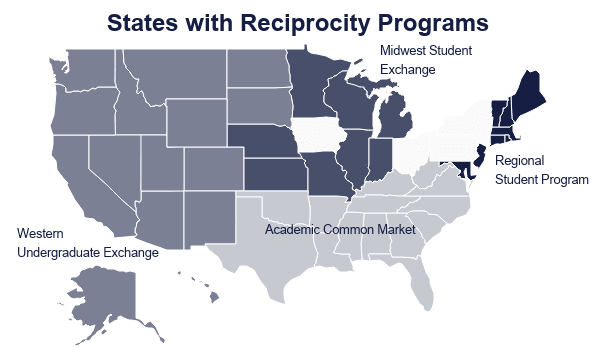
Even with financial aid, seventy% of universities are unaffordable for almost working-class and centre-grade students.
Analysis: Why is College And so Expensive?
Some of the biggest contributors to the increasing costs of attending college include increased need, increased availability of financial aid, and more than civilities designed to attract higher-paying students.
- In 2017, at that place were 5.ane 1000000 more than students attending college than there were in 2000.
- Increased availability of fiscal aid for students represents increased funding from federal sources for institutions.
- For-turn a profit schools charge 75% more in tuition when students are eligible for federal loans.
- Students increasingly nourish college abroad from home.
- Increasingly, colleges are spending more on administrative fees.
- Educatee civilities tin account for equally much every bit $3,000 per educatee per year.
- Betwixt 1975 and 2005, the number of administrators had increased by 85% and administrative staffers by over 240%.
- Between 1993 and 2007, instructional spending per educatee increased by 39% compared to 61% increase in administrative spending per student.
- Colleges are increasingly hiring adjunct professors (non-tenure runway and paid less than full-time professors) to save money.
- Between 2003 and 2013, non-tenure track faculty (adjuncts) had increased from 45% to 62% in four-year schools.
- In 2018, 73% of all faculty positions were non-tenure rails (adjuncts or yearly contracted).
- In 2016, higher-ed institutions hired 21,511 full-time tenure-rail faculty compared to 30,865 non-tenure rails faculty.
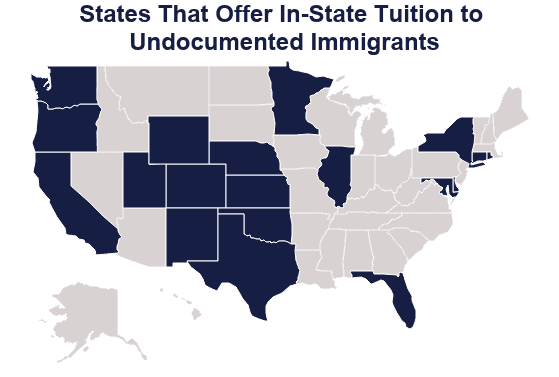
College Revenues & Operating Costs
The education industry is a multi-billion-dollar market, with cumulative revenues exceeding $415 billion.
- The average postsecondary establishment's annual acquirement is $216,917,478.
- Near postsecondary acquirement (xix.3%) comes from tuition and fees.
- eighteen.4% of acquirement comes from State appropriations.
- 13.2% comes from sales and services from hospitals.
- Federal grants and contracts provide vii.6% of institutional acquirement.
- Nonoperating federal grants account for six.4% of revenue.
- Annual operating expenses boilerplate $212,174,389 or 97.viii% of acquirement.
- Instruction accounts for most operating costs (27.8%).
- Additional major operating costs include hospital services (13.5%), inquiry (9.6%), institutional back up (9.1%), and "other expenses and deductions" (9.two%).[i]
For more on educational activity spending, see our report on U.Due south. Public Educational activity Spending.
Sources
- NCES, Integrated Postsecondary Education Data Organisation (IPEDS)
- SchoolMoney.Org, "College Tuition: Where Does the Money Go?"
- U.S. Section of Education's Higher Affordability and Transparency Center
- Southern Regional Education Board, "Academic Mutual Market."
- National Conference of State Legislatures, "Undocumented Student Tuition: Overview."
- Parent Toolkit, "Public vs. Private Colleges."
- Federal Student Help, "Federal Pell Grants."
- National Eye for Education Statistics (NCES), Digest of Pedagogy Statistics.
- The Future of Statewide College Promise Programs
- Tuition and State Appropriations
- Federal and Land Funding of Higher Education
- Many Colleges Miscalculate Off-Campus Housing Costs
- Does Federal Student Aid Raise Tuition? New Evidence on For-Turn a profit Colleges
- Pedagogy at a Glance 2018: OECD Indicators
- Federal Student Assistance, "FSEOG Grant."
- The Hechinger Report, "Are Too Few Higher Students Request for Federal Help?"
- Bureau of Labor Statistics, Measuring the Value of Education
- Federal Paycheck Computer
- Academy of California – Berkeley, Student Budgets (Price of Attendance)
- Stanford University, Community Housing: Housing Types and Costs
Source: https://educationdata.org/average-cost-of-college
Posted by: wagnerimme1941.blogspot.com

0 Response to "How Much Money Is College For A Semester"
Post a Comment